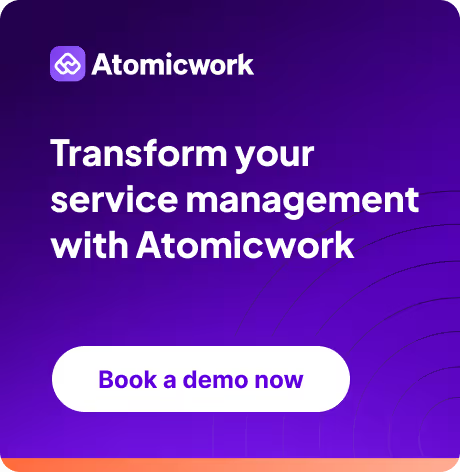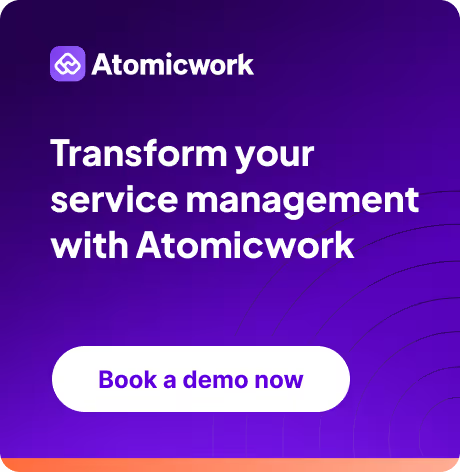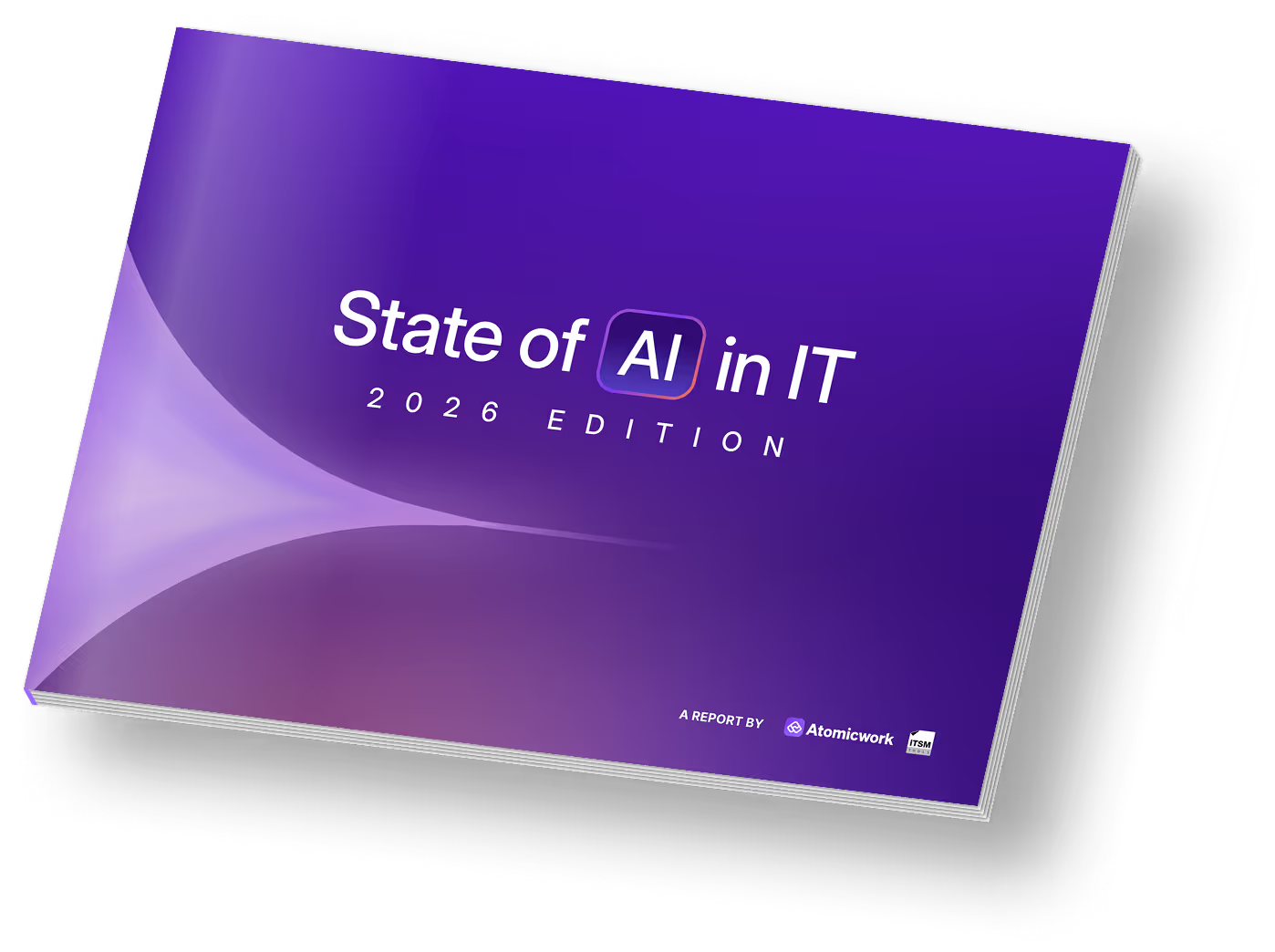70-80% of AI projects in IT organizations fail. Here’s why.

“If the only tool you have is a hammer, you will start treating all your problems like a nail.” – Abraham Maslow
While the quote has many variations and attributions, the message is clear – over-reliance on one tool or approach creates cognitive blind spots.
“Adopting” AI in IT is no different. You’ll be better off focusing on the problem or the goal rather than implementing AI, the tool. If there’s one thing you take away from this article, let it be this.
The growing investment in AI across IT organizations is evident as we enter 2025.
According to a recent study we conducted on the state of AI in IT, 31% of IT teams are at maturity level 3 of AI adoption (using enterprise AI software while discouraging consumer AI use for work). Only 7% are at level 5, adopting AI with vigor while 5% of organizations had no plans to implement AI.

From a mindset perspective, these two seemingly conflicting tenets from my conversation with Charles Araujo, the founder of The Institute for Digital Transformation, capture the current state of AI adoption:
- AI is a means to an end. The end goal is more important than a specific tool or technology.
- The hype will compel your competition to try and adopt AI. Since they’re not standing still, neither can you.
Since you’re reading this, I’ll assume that you already buy into point #2. IT organizations that are not looking at business problems and opportunities and asking themselves, “Where can we leverage AI to solve these?” will be at a disadvantage once the dust settles.
There are a ton of potential applications of AI in ITSM, including deflecting repetitive tickets, improving agent productivity, enhancing user experiences at scale and so much more.
So why, despite the clear benefits and growing adoption, are some organizations still struggling to embrace AI effectively? The answer often comes down to understanding that 70-80% of AI initiatives fail, not because of the technology itself but due to strategic and implementation flaws.

What are the potential roadblocks?
If AI has so many apparent applications in ITSM, why aren’t they happening?
In a McKinsey interview, McKinsey senior partner Harry Robinson talks about why 70% of transformations (in general, not just AI) fail.
The three main reasons highlighted by Robinson include:
- Inadequate leadership aspiration
- Skills and capability gaps
- Neglect of procedural elements
The ‘State of AI in IT 2025’ report echoes these sentiments. One of the questions we asked IT professionals was about the barriers to AI adoption. We found these to be the most common barriers.

1. Governance and compliance (51%): The foremost barrier to AI adoption is the challenge of governance and compliance, with more than half of the respondents citing it as their primary concern.
IT leaders face the complex task of implementing innovative AI solutions while ensuring adherence to regulatory requirements and establishing proper governance frameworks.
This barrier’s prominence has increased significantly, showing organizations’ growing awareness of the need for structured and compliant approaches to AI implementation. The high percentage also reflects the broader industry challenge of maintaining innovation momentum while operating within regulatory boundaries.
2. Data security and privacy (47% & 43%): The dual concerns of customer data security (47%) and employee data privacy (43%) represent a significant roadblock in AI adoption.
Organizations must navigate the complex landscape of data protection while implementing AI solutions that require access to sensitive information. The nearly equal concern for both customer and employee data underscores the need for comprehensive security measures and robust data protection frameworks in AI implementations.
3. Lack of AI expertise (41%): The talent gap in AI implementation impacts both the initial implementation phase and ongoing management of AI systems.
The challenge is particularly notable considering that only 7% of organizations are at Level 5 maturity in AI adoption.
The skills shortage manifests in various ways, from difficulty in identifying use cases to challenges in maintaining and optimizing AI systems. This barrier highlights the critical need for focused training programs and strategic talent development initiatives.
4. Additional implementation costs (36%): Budget constraints remain a significant obstacle.
The report reveals a striking correlation: 94% of cases reporting negative ROI came from organizations allocating less than 10% of their IT budget to AI initiatives. Conversely, 71% of positive ROI cases were from organizations investing more than 10% of their IT budget in AI.
This data demonstrates that successful AI implementation requires a significant financial commitment and inadequate funding often leads to poor outcomes and reduced trust in AI solutions.
5. Unclear ROI and organizational inertia (31 & 27%): The uncertainty surrounding return on investment and organizational inertia presents a complex barrier to AI adoption.
The report reveals a critical insight from Stephen Mann, Principal Analyst and Content Director ITSM.tools.
Trust in AI-driven IT systems correlates with AI ROI success–all of the respondents who didn't trust AI also reported a negative ROI from their AI investments. Stephen Mann, Principal Analyst and Content Director ITSM.tools
This creates a challenging cycle where a lack of trust leads to reduced investment, resulting in poor ROI, which further diminishes trust. Breaking this cycle requires organizations to focus on demonstrable successes through smaller, measurable projects that can build credibility and confidence and then take on more complex projects.
How can you increase the odds of success?
Based on all these factors, we can distil down a few things to keep in mind when planning your next AI initiative.
1. Pick a goal that’s a business priority
Leadership buy-in is important to ensure that the project gets not only the resources but also a top-down push when you’re met with lateral resistance.
A project involving a relatively new technology, like AI, is bound to run into challenges and failed experiments. If you’ve set out to solve a problem that’s critical to the business, you can expect sustained availability of resources and leadership backing to coast through them.
AI offers the opportunity to move from a reactive to a proactive IT model, using incident and problem management as diagnostic tools to analyze the operational performance of a company's collective tech stack and preemptively address issues before they disrupt business workflows. Mark Settle, former CIO of Okta and BMC Software
2. Build robust governance frameworks
Start by establishing clear AI governance frameworks and addressing ethical considerations, data governance, and the need for continuous skill development.
The TRUST framework developed by Atomicwork provides a structured approach. It ensures that AI systems are transparent, responsible, user-centric, secure, and traceable and that they meet the highest enterprise security, compliance, and safety standards.
Governance should be viewed as an enabler rather than a constraint, helping organizations scale AI responsibly while maintaining compliance and ethical standards.
The beauty of AI is it forces us to think of security from the beginning, and not as an afterthought. When security and IT are aligned, we innovate faster, build trust with our customers, and create products that are not only competitive but resilient. Aysha Khan, CIO and CISO of Treasure Data
3. Understand that changing user behavior is hard
Human nature gravitates toward the path of least resistance, especially in technology adoption. It’s been a consistent pattern from the use of electricity to Netflix to Amazon, and now AI in the workplace.
With 71% of end users already using consumer AI tools at work, there's a strong natural momentum for AI adoption. What IT teams often view as ‘shadow IT’ is typically users seeking efficient solutions to real problems.
Rather than fighting this tide by clamping down on unauthorized tools, organizations should understand what value users are seeking and help them achieve their goals through safer alternatives. This transforms IT from being perceived as a roadblock to an enabler of efficient, secure solutions.
On that note: At Atomicwork, we believe that asking end users to visit portals (or remember different email IDs for IT, HR, etc.) to access support is flawed.
We think you should bring support to where they already are – tools like Microsoft Teams and Slack.
Ask our team of AI-based ITSM experts for a demo.
4. Start nurturing talent early on through hiring and training
One roadblock that both McKinsey and our research found is the lack of the right skills and talent. Since AI teams haven’t been a thing for too long, finding the right talent can take time. AI is a broad term that encapsulates Machine Learning, GenAI, Agentic AI, Computer Vision, and more. Prioritize hiring and training for the bespoke skills you need.
There’s a lot of focus on AI automating jobs, but that’s not always negative. It’s a great opportunity to upskill your staff in areas like prompt engineering, data governance, AI ethics, and knowledge management — skills that will help them thrive even as AI reshapes certain roles. Roy Atkinson, CEO of Clifton Butterfield LLC
Also, have a “build vs buy” discussion early on. You might not need to spend a ton of time and money on building AI-based systems in-house unless you’re hoping that the AI-based solution gives you a unique competitive advantage.
5. Change manage the program with the end user in mind
The IT version of change management addresses the technical side of the planning, rollout, and, if required, rollback process. Another important part of rolling out an org-wide change is the human aspect.
Have a pre-launch, launch, and post-launch plan. During the days leading up to the launch, communicate the benefits of the technology to the end users and show them how their lives would be better because of it. Post-launch, give them a channel to share feedback and show them how you're addressing or acting on it.
A positive attitude is contagious, and it's amazing what a team can achieve with the right mindset. Slowly but surely, involve everyone from the service desk to leadership to feel connected to the bigger picture — ask them for inputs to show how their work contributes to the bigger picture. Mark Gill, Senior Director of IT at Zuora
6. Track progress and continually improve
Finally, make sure that you have the analytics and tracking in place to monitor the performance of your initiative. GenAI is yet to evolve to a 100% accuracy and hallucinations are still a big concern for IT and users alike. To avoid eroding the trust of end users, it’s important to track inaccuracies that make them revert to the usual method.
If GenAI is a big part of your offering, remember that it’s only as good as the data and knowledge base that you feed it. Qualitative feedback and quantitative data will help you improve the efficacy of the data and the quality of responses over time.
Conclusion
Nothing like sharing another implementation stand-out example to conclude.
Chad Ghosn, CIO and CTO at AMMEX Corp, was looking for a way to drive employees to find their own answers without increasing headcount. They used Atomicwork as a means to that end and went from 20% ticket deflection to 65%.
This is a small glimpse into what AI can help achieve. To put it plainly, AI adoption in ITSM isn’t really about AI. It is about using AI effectively to achieve clear-cut business goals. AI is a great medium, given its immense potential and promise.
It is important for organizations to do a deep evaluation and get started with low-stakes IT projects to rake up quick wins, learn from them, and then move on to bigger and more ambitious projects.
You may also like...


































